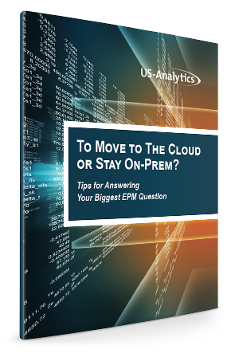So, you didn’t make it to Kscope18 or, if you did, you missed the part about the financial close roadmap. No worries — we’ll cover the timeline and new features coming to on-prem financial close tools in this blog post. We’ll even give you an update of what’s coming to Oracle’s Financial Consolidation and Close Service (FCCS). With the release date for the new version (11.2) right around the corner, we understand how important it is for your organization to get the full picture, so decision-makers can make the best next step.
In this blog post, we’ll cover the timeline for 11.2 and previous versions, features coming to HFM and FCM, as well as how FCCS stacks up.
Note: Any updates to features, functionality, or timing mentioned in this blog post are subject to change at the sole discretion of Oracle.
Timeline
It was only last year that Oracle announced its plan to come out with the reportedly last version of its on-prem EPM tools. Things are moving pretty fast with 11.2 scheduled for an early 2019 release. And though things occasionally get put off, 11.2 should definitely be released in the first half of next year, according to Rich Wilkie, the Senior Director of EPM Product Management.
The timeline hasn’t really changed since last year, but it’s always good to have a refresher of what’s going on.
Versions 11.1.2.3 or lower lost S1 defect fixing in March 2018. However, 11.1.2.4 will have defect fixing, third party certification updates, and enhancements until December 2020. Meanwhile, the next (and reportedly last) on-prem version, 11.2, is scheduled for release by the first quarter of 2019.
These dates don’t really match up, giving on-prem financial close customers a lot to think about. 11.1.2.4 customers don’t have much to worry about for the next two years, but 11.1.2.3 or lower need to decide if they want to…
- Upgrade to 11.1.2.4
- Wait to upgrade until 11.2 is released
- Move to the cloud
- Or consider another technology
If you’re still on the fence about the cloud in general and the decision-makers at your organization are still confused about what it means, check out the eBook: To Move to the Cloud or Stay On-Prem?
But, if you’re wanting to wait and see what features the 11.2 version of HFM and FCM will have compared to Oracle Planning and Budgeting Cloud Service (PBCS), you’re in the right place. We’ll cover that in the next couple of sections, but first you should be aware of a few support terms.
Oracle Support Terms
The below graphic gives you a general idea of the timeline of support for each version of your EPM products. You’ll notice that “sustaining support” goes off the map – that’s because it’s indefinite.
Oracle has three different types of support for its products: Premier, Extended, and Sustaining.
Premier Support gives you access to comprehensive maintenance and software upgrades for five years from the general availability (GA) date.
Extended Support gives you control of your Database, Middleware, and Applications upgrade strategy with additional maintenance and upgrades for an additional fee.
Sustaining Support provides maintenance for as long as you use your Oracle software. You gain access to Oracle online support tools, upgrade rights, pre-existing fixes and assistance from technical support experts.
If you need more guidance on lifetime support stages, check out this page. You can also check out the Oracle Lifetime Support Policy for support information about specific products.
New Features in HFM
As you know, there are still patch set updates coming out for HFM 11.1.2.4, so we’ll look at some of those new features as well as 11.2.
But first, it’s important to note that last year, the roadmap showed plans to add the simplified user interface to HFM. However, Wilkie said that the current plan is to use Workspace across every 11.2 EPM on-prem solution. It could change, but, for now, that’s where the products are headed.
HFM 11.1.2.4.205 Features
This HFM release includes…
- Data Insights
- Statistics on data tables
- Sorted by scenario and year
- Number of records with…
- Invalid data
- Foreign currency data
- Input data
- Calculated data
- Size of the data tables
Some of the key benefits of this release is that you can better monitor your application and system, so you can take action before issues arise.
HFM 11.2 Features
Of course, most of the innovation is going to the cloud, but there are some cool new HFM features you can look forward to in 11.2.
- Automatic consolidations
- During non-peak hours, the system will monitor and consolidate without the user telling it to
- This feature will recognize when users are active and back away so that it doesn’t interfere
- You can turn off this feature if needed
- Configurable
- Tell it when to consolidate
- Tell it where to consolidate
- Multiple POV
- Configurable hardware allocation
- Web-based metadata editor
- Archiving/deleting unwanted data
- Performance improvements
- Smart View
- Batch Processing
The big draw of these new features is definitely the automatically consolidation. It’s a huge benefit to know that your data is always consolidated. Some other notable benefits of automatic consolidations include…
- Consolidations are triggered by impacted data
- In the auto consolidation window, the system keeps checking impacted data and consolidates
- It will automatically suspend when it detects other activity
- Round robin executive to consolidate dependent POVs
As of Kscope18, these are the major features coming to HFM 11.2; however, things could change as we get closer to the first half of 2019. We’ll keep you updated on our blog as we find out more.
New Features in FCM
FCM did not receive as much coverage as other products at Kscope, but one notable topic was a 2016 patch set update for 11.1.2.4 that fixed a huge issue for FCM users. We’ll look at that first and then tell you what we know about 11.1.2.4.250.
FCM 11.1.2.4.200
The most notable change in this release was the removal of SOA, which was challenging to configure and maintain for large-scale corporate implementations. SOA removal benefits you most because it simplified the architecture and drove workflow to Close Manager (CM) as well as Account Reconciliation Manager (ARM).
This updated also included…
FCM
- Saved Views
- Rules Enhancements in CM and ARM
- Reopen tasks and reconciliations
- User IDs in Pick Lists
- 30-column transactional dashboards
Close Manager (CM)
- Change task owner
- Delete tasks
- Task submission
Account Reconciliation Manager (ARM)
- Export all columns removed
Supplemental Data Management (SDM)
- Currency Translation
- Bulk loading data
To learn more about some of the highlights from this update, check out the blog post.
FCM 11.1.2.4.250
One of the more significant features in this update is that you can do an LCM app snapshot of ARM and move to the cloud. There are several account reconciliation features that are only available and will only be available in the cloud, such as transaction matching.
Other features in this update include…
FCM
- Date calculations
- Multi-file uploads
- Archiving
ARM
- Variance Analysis
- Reconciliation archive
- Bulk submit/approve
CM
- Excel add-in to interact with tasks
SDM
- Team assignments
- Configurable column width
- Change import file delimiter
- Allow negative start data offset
What’s New and Coming Soon to FCCS?
The intent of FCCS is to combine everything you need from HFM, FCM, FDM, and SDM into one application. And, of course, account reconciliations are covered in one cloud-based application — ARCS.
This all sounds great, but many users have had trouble transitioning from HFM to FCCS, since not all HFM features were covered in FCCS.
However, Oracle says that all major HFM capabilities are now available in FCCS. These include…
- Currency translation adjustment (17.04)
- Copy and clear (17.06)
- Movement enhancement for balance sheet accounts (17.07)
- Configurable calculations (17.11)
- Configurable translations (17.08)
- Advanced consolidations (17.12)
- Ownership management (17.12)
- Journals – auto reversing, attachments (18.01)
- Configurable consolidation rules (18.04)
- Extended dimensionality (under preview)
Like with the on-prem roadmap, Oracle also has a cloud roadmap for FCCS. This is what it currently looks like…
Recent Highlights
- Use CM and SDM standalone
- Advanced Consolidations
- Manage Ownership
- Proportional Consolidations
- Equity eliminations
- Org by period
- Configurable rules
- Configurable translations
- Integrated EPM business processes
- Configurable calculations
- Close Manager
- Intelligent process automation
- Team-based assignments
- User-defined reporting
- Autonomous Consolidations
Research & Development Underway
- Extend custom dimensions
- Intuitive and searchable error logging for easy debugging
- Archiving of data
- User interface updates
- Favorites/last used
- UI integration with ERP cloud
- Process Control
- HFM Migration Toolkit
- Calculations
- Ability to call specific calculations
- SDM
- Additional calculation rules
- Smart View for data sets
Looking Forward
- Journal entries
- Integration with any ERP
- Recurring
- Single click create
- Predictive Actions
- Advanced Consolidation
- Automatic journaling
- Ownership register
- More pre-seeded rule
- Intercompany Matching
- Security as partner
- More matching options
- Event-based alerts






